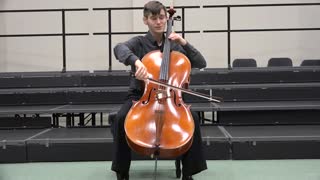Alessandro Stradella Sinfonia for violin, cello & b c in D minor IAS 32 McC 22
#AlessandroStradella #Sinfonia #Violin #Cello #BassoContinuo #DMinor #IAS32 #McC22 #ClassicalMusic #MusicalComposition #BaroqueEra #ItalianComposer #InstrumentalMusic
Publication date 1954
Trio di Bolzano
Nunzio Montanari (piano)
Giannino Carpi (violin)
Antonio Valisi (’cello)
Alessandro Stradella, an influential Italian composer of the Baroque era, has left an indelible mark on the world of classical music. Among his notable works, the Sinfonia for Violin, Cello & Basso Continuo in D minor, IAS 32 McC 22, stands as a testament to his compositional prowess.
Composed during the Baroque era, a time of great artistic and musical flourishing, Stradella's Sinfonia reflects the stylistic characteristics and innovations of the period. As an Italian composer, Stradella played a significant role in shaping the musical landscape of his time, and this composition showcases his mastery in combining melody, harmony, and virtuosity.
The Sinfonia for Violin, Cello & Basso Continuo in D minor comprises several movements that showcase Stradella's ability to craft engaging and dynamic instrumental music.
1. Introduction:
The sinfonia begins with a captivating introduction that establishes the key and sets the mood for the piece. Stradella's use of rich harmonies and a driving rhythm immediately captures the attention of the listener, drawing them into the world of the composition.
2. Allegro:
The first movement, marked Allegro, unfolds with a lively and energetic character. The violin and cello engage in a spirited dialogue, showcasing their technical prowess and musical agility. Stradella's use of counterpoint and interplay between the instruments creates a sense of musical conversation and exploration.
3. Adagio:
Following the exuberant Allegro, the Adagio movement provides a contrasting and introspective moment within the sinfonia. The violin and cello take turns expressing poignant and lyrical melodies, accompanied by the basso continuo. Stradella's use of expressive harmonies and ornamentation adds depth and emotional richness to this movement.
4. Allegro finale:
The final movement, marked Allegro, brings the sinfonia to a thrilling conclusion. Stradella's skillful composition and use of virtuosic passages showcase the technical abilities of the violin and cello. The movement combines elements of dance-like rhythms with intricate melodic patterns, creating a sense of excitement and anticipation.
Stradella's Sinfonia for Violin, Cello & Basso Continuo in D minor has had a lasting impact on the world of instrumental music. Its technical brilliance, emotive melodies, and seamless interplay between instruments have influenced subsequent composers and performers. Stradella's ability to blend virtuosity with expressive depth has made this sinfonia a staple in the repertoire of chamber music.
Conclusion:
Alessandro Stradella's Sinfonia for Violin, Cello & Basso Continuo in D minor, IAS 32 McC 22, is a testament to the composer's mastery of Baroque instrumental music. Through its vibrant and dynamic musical structure, the composition showcases Stradella's ability to create engaging dialogues between instruments and evoke a range of emotions. As we continue to appreciate and study this remarkable piece, we gain a deeper understanding of Stradella's contribution to the rich tapestry of classical music.
You have the opportunity to support the channel:
https://destream.net/live/RadSiarAl/donate
https://www.buymeacoffee.com/6355radsiaral
-
 28:21
28:21
DoseOfChill
7 months agoGiovanni Battista Viotti: Violin Concerto No.22 in A minor
92 -
 13:51
13:51
Gnostic Library
10 months ago💥 ANTONIO SALIERI ❯ Chamber Concerto for Oboe, 2 Violins, Viola & Violoncello in G Major 🎶
7 -
 5:28
5:28
JonathanSimmonsCello
3 years ago $0.01 earnedBach Cello Suite No. 2 in D Minor, IV. Sarabande - Jonathan Simmons, Cello
85 -
 8:07
8:07
Classical music_Music Inspiration
1 year agoAntonio Vivaldi La Stravaganza Violin Concerto In D Minor №8 Op 4
1 -
 1:18
1:18
Washington's Camerata Music
3 years agoIgnatius Sancho (c. 1729-1780), Air for German Flute, Violin, and Basso
18 -
 9:51
9:51
Classical music_Music Inspiration
1 year agoAntonio Vivaldi The Stravaganza Violin Concerto In F Major №9 Op 4
4 -
![Tomaso Albinoni: Adagio for organ and strings in G minor [Arr. Remo Giazotto]](https://hugh.cdn.rumble.cloud/s/s8/1/C/9/P/8/C9P8o.0kob-small-Tomaso-Albinoni-Adagio-for-.jpg) 8:51
8:51
DoseOfChill
6 months agoTomaso Albinoni: Adagio for organ and strings in G minor [Arr. Remo Giazotto]
69 -
 10:02
10:02
Gnostic Library
9 months ago💥 ANTONIO SALIERI ❯ Organ Concerto ❯ Allegro Assai 🎶
23 -
 10:02
10:02
Librería Gnóstica
9 months ago💥 ANTONIO SALIERI ❯ Organ Concerto ❯ Allegro Assai 🎶
17 -
 5:41
5:41
Librería Gnóstica
10 months ago💥 ANTONIO SALIERI ❯ Organ Concerto ❯ Allegro Assai 🎶
7